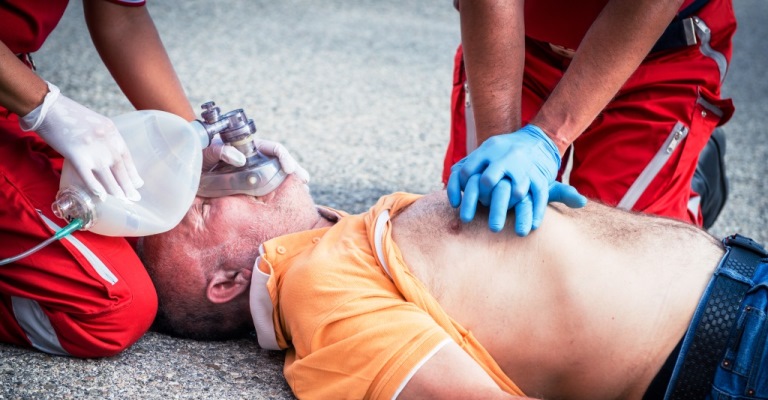
6 Common Emergency First Aid Mistakes
Emergencies often strike without warning. It can be too easy to make first aid mistakes in these situations despite one’s good intentions to provide help
From what not to do in nosebleed accidents to old wives’ tales that make a burn worse, here are first aid mistakes a responder should avoid in case of an emergency.
FIRST AID TRAINING? VISIT THE DMC DINAS MEDICAL CONSULTANTS BOOTH AT EMERGENCY EXPO
First Aid Myths and Mistakes
Everyone may want to step in and help in an emergency. But sometimes, lack of training in first aid response can harm or endanger a casualty’s life.
Many remember some essential first aid elements and rules.
The question is whether that knowledge is still correct or somewhat fragment memories that have lost their usefulness.
Several widespread and dangerous mistakes happen in the desire to help others.
Some may cause discomfort and interrupt the healing process unless it receives proper treatment.
Knowing and understanding some of the most common dangerous first aid mistakes one should never put into practice is vital.
THE RADIO OF THE WORLD’S RESCUERS? VISIT THE RADIO EMS BOOTH AT EMERGENCY EXPO
Here are six common first aid mistakes one should avoid
-
Putting ice on a burn
Applying ice on the burn site only causes frostbite and other skin damage.
Putting on butter and toothpaste are also wide-known myths that can only worsen an injury.
Treatment for burns should start with proper cleaning and cooling process.
Run the burned area under cool water for about five to ten minutes.
Alternatively, use a clean, cool, and wet cloth to the injury site.
Apply topical antibiotic cream to prevent infection and take OTC medications (such as acetaminophen or ibuprofen) to ease pain and swelling.
Remove any clothing that covers the burn but does not peel it away if it adheres to the skin.
Doing so will only cause more damage to the underlying skin.
-
Leaning back during a nosebleed
It is a common first aid mistake to lean back during a nosebleed, which will only make the blood run down a person’s throat and swallow it.
Swallowing blood can lead to stomach irritation and vomiting.
Leaning back during a nosebleed does nothing to control the bleeding.
Instead, lean forward and pinch the tip of the person’s nose.
Leave it for ten minutes and observe if it stops on its own.
If this does not help, immediately rush to a doctor to determine the condition.
-
Moving an injured, unconscious casualty
Do not move an injured casualty involved in a road collision or vehicular accident.
Doing so will only make the situation worse.
Disregard this rule only in extreme conditions, such as a vehicle catching fire or ongoing traffic within the area.
If the situation is not extreme, call an ambulance and try to turn off the vehicle’s engine.
Try to stop any bleeding and help the victim remain stable until emergency services can take over the scene.
-
Putting heat on sprain or fracture
It is a fact that heat can soothe aches and pain, but it is no help in treating sprain or fracture.
Doing so can only increase the swelling and pain.
Use the RICE treatment for sprains and fractures.
Apply a cold compress to the injury site for 20 minutes on and off.
When possible, raise the sprained or fracture area to help with the blood circulation and reduce swelling.
-
Applying a tourniquet to any bleeding
In a bleeding emergency, it is a mistake to squeeze a tourniquet over the wound immediately.
This mistake can cause permanent nerve and muscle damage and lifelong lesions in the tissues and blood vessels.
The use of this technique does not stop arterial bleeding.
Instead of using a tourniquet, apply pressure directly on the wound to stop the bleeding and prevent damage.
Bandage the area with fresh gauze and elevate.
-
Giving CPR after a heart attack
A heart attack occurs when part of the heart muscle does not receive enough blood.
In most cases, the person is still conscious and breathing, which means they do not need CPR.
The person does not need CPR unless the heart attack develops into cardiac arrest, in which the person is rendered unconscious and not breathing.
In a cardiac arrest, push hard and fast in the centre of the person’s chest until an ambulance arrives.
Hands-only CPR proves to be more effective than a conventional resuscitation with rescue breathes in the first few minutes of the attack.
Learning First Aid Can Make a Big Difference
It is all too easy to forget your first aid knowledge in a state of panic.
These common first aid mistakes only make things worse for an injured casualty.
There is no question that formal first aid training can make a big difference in these situations.
It prompts people to be more alert in the surroundings they are well in and promotes an overall sense of safety.
Learn first aid today and avoid making these six critical first aid mistakes.
Read Also:
Emergency Live Even More…Live: Download The New Free App Of Your Newspaper For IOS And Android
What Should Be In A Paediatric First Aid Kit
Ukraine Under Attack, Ministry Of Health Advises Citizens About First Aid For Thermal Burn
Electric Shock First Aid And Treatment
RICE Treatment For Soft Tissue Injuries
How To Carry Out Primary Survey Using The DRABC In First Aid
Heimlich Maneuver: Find Out What It Is And How To Do It
10 Basic First Aid Procedures: Getting Someone Through A Medical Crisis
Wound Treatment: 3 Common Mistakes That Cause More HARM Than Good
Most Common Mistakes Of First Responders On A Patient Affected By Shock?
Emergency Responders On Crime Scenes – 6 Most Common Mistakes
Manual Ventilation, 5 Things To Keep In Mind
10 Steps To Perform A Correct Spinal Immobilization Of A Trauma Patient


